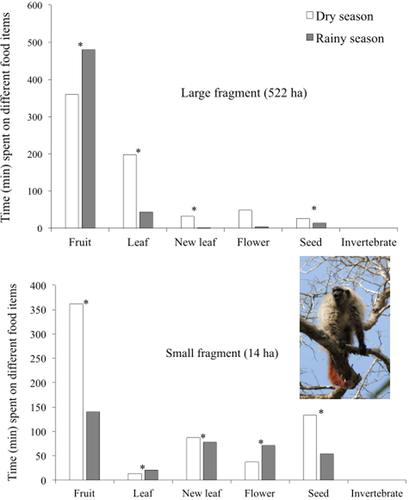当前位置:
X-MOL 学术
›
Am. J. Primatol.
›
论文详情
Our official English website, www.x-mol.net, welcomes your feedback! (Note: you will need to create a separate account there.)
Food availability, plant diversity, and vegetation structure drive behavioral and ecological variation in Endangered Coimbra‐Filho's titi monkeys
American Journal of Primatology ( IF 2.4 ) Pub Date : 2021-02-02 , DOI: 10.1002/ajp.23237 João P Souza-Alves 1, 2, 3 , Renata R D Chagas 2 , Marina M Santana 4 , Sarah A Boyle 5 , Bruna M Bezerra 1, 3
American Journal of Primatology ( IF 2.4 ) Pub Date : 2021-02-02 , DOI: 10.1002/ajp.23237 João P Souza-Alves 1, 2, 3 , Renata R D Chagas 2 , Marina M Santana 4 , Sarah A Boyle 5 , Bruna M Bezerra 1, 3
Affiliation

|
There is wide variability in primate behavior and ecology. Understanding how frugivorous primates behave under different habitat fragmentation levels is key for effective conservation and management of species and their habitats. We evaluated the seasonality in activity budget, diet, and ranging behavior of two groups of Endangered Coimbra‐Filho's titi monkeys (Callicebus coimbrai). One group inhabited a 14‐ha forest fragment, whereas the other lived in a 522‐ha fragment. We measured the monthly density of trees and lianas available as food sources over 8 months. We also collected behavioral and group location data every 5 min, from dawn to dusk, using the scan sampling method. The two forest fragments differed seasonally in the number of fruiting food‐resource available. In the 14‐ha fragment, we found that the time spent by titi monkeys feeding, foraging, resting, and traveling differed seasonally. In the 522‐ha fragment, titi monkeys exhibited seasonal differences in time spent sleeping, socializing, foraging, and revisiting food sources. In both titi monkey groups, diets varied seasonally. Our findings indicate that Coimbra‐Filho's titi monkeys can exhibit behavioral flexibility in their activity budgets, diets, and movement patterns. Such flexibility is important for this species to survive in fragmented habitats and may be linked to three key factors: species‐specific resource availability, plant species diversity, and the vegetation structure of each forest fragment.
中文翻译:

食物供应、植物多样性和植被结构驱动濒临灭绝的科英布拉-菲略猴的行为和生态变化
灵长类动物的行为和生态变化很大。了解食果灵长类动物在不同栖息地破碎化水平下的行为是有效保护和管理物种及其栖息地的关键。我们评估了两组濒危科英布拉-菲略猴 ( Callicebus coimbrai)在活动预算、饮食和范围行为方面的季节性)。一组居住在 14 公顷的森林碎片中,而另一组居住在 522 公顷的碎片中。我们测量了 8 个月内可用作食物来源的树木和藤本植物的月度密度。我们还使用扫描采样方法,从黎明到黄昏,每 5 分钟收集一次行为和群体位置数据。这两个森林片段在可用的果实食物资源数量上存在季节性差异。在 14 公顷的片段中,我们发现山雀进食、觅食、休息和旅行所花费的时间因季节而异。在 522 公顷的片段中,titi 猴子在睡眠、社交、觅食和重新访问食物来源的时间上表现出季节性差异。在两个titi猴子群体中,饮食随季节变化。我们的研究结果表明,科英布拉-菲略猴的活动预算、饮食、和运动模式。这种灵活性对于该物种在支离破碎的栖息地中生存很重要,并且可能与三个关键因素有关:特定物种的资源可用性、植物物种多样性和每个森林碎片的植被结构。
更新日期:2021-02-23
中文翻译:

食物供应、植物多样性和植被结构驱动濒临灭绝的科英布拉-菲略猴的行为和生态变化
灵长类动物的行为和生态变化很大。了解食果灵长类动物在不同栖息地破碎化水平下的行为是有效保护和管理物种及其栖息地的关键。我们评估了两组濒危科英布拉-菲略猴 ( Callicebus coimbrai)在活动预算、饮食和范围行为方面的季节性)。一组居住在 14 公顷的森林碎片中,而另一组居住在 522 公顷的碎片中。我们测量了 8 个月内可用作食物来源的树木和藤本植物的月度密度。我们还使用扫描采样方法,从黎明到黄昏,每 5 分钟收集一次行为和群体位置数据。这两个森林片段在可用的果实食物资源数量上存在季节性差异。在 14 公顷的片段中,我们发现山雀进食、觅食、休息和旅行所花费的时间因季节而异。在 522 公顷的片段中,titi 猴子在睡眠、社交、觅食和重新访问食物来源的时间上表现出季节性差异。在两个titi猴子群体中,饮食随季节变化。我们的研究结果表明,科英布拉-菲略猴的活动预算、饮食、和运动模式。这种灵活性对于该物种在支离破碎的栖息地中生存很重要,并且可能与三个关键因素有关:特定物种的资源可用性、植物物种多样性和每个森林碎片的植被结构。



























 京公网安备 11010802027423号
京公网安备 11010802027423号